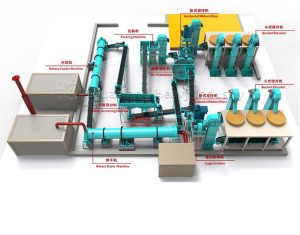The process of producing organic fertilizer can be simply divided into three processes: pre-treatment, primary fermentation, and post-treatment.
The first step of the process of producing organic fertilizer: pre-treatment. After the compost raw materials are transported to the yard, they are weighed on the scale and sent to the mixing and stirring device. They cannot be mixed with production and domestic organic wastewater in the factory, and must be mixed with clean water. Then add organic biological fermentation compound bacteria, and roughly adjust the pile according to the raw material composition, and enter the next process after mixing. When mixing the ingredients, the brown sugar must be dissolved in water first, and then the organic fertilizer fermentation biological bacteria are added and fully stirred, and then the diluent is evenly sprinkled on the raw materials, and fully stirred with a mixer.

Note: The compost raw materials should be processed several hours in advance and soaked with water. The water used to dilute the biological fermentation bacteria should be regarded as drinking water without disinfectants (such as bleaching powder, etc.).
The second step of the process of producing organic fertilizer: primary fermentation. The mixed raw materials are sent to the primary fermentation workshop by a loader and piled into a fermentation pile. At the same time, the pile is turned over every 2 days, and water and nutrients are added. The fermentation temperature is controlled at 50℃~65℃ (hot to the touch) for aerobic fermentation. The fermentation cycle of this project is 8 days. One pool of raw materials is put in and one pool of semi-finished products is taken out every day. After the fermented semi-finished products are discharged, they are ready to enter the next process.
The third step of the process of producing organic fertilizer: post-processing. The finished compost is further screened, and the screened materials are treated according to the moisture content. After the screened materials are granulated, they are sent to the dryer for drying, and various additives are added in proportion and stirred and mixed to make finished products, which are packaged and stored for sale. The screened materials are returned to the crushing process for reuse.


